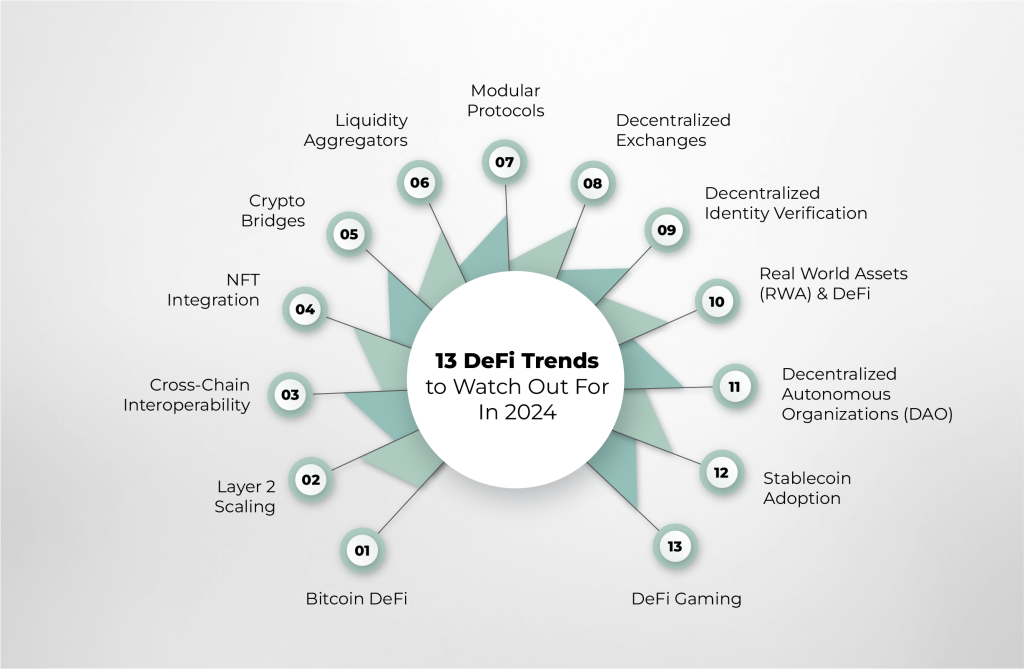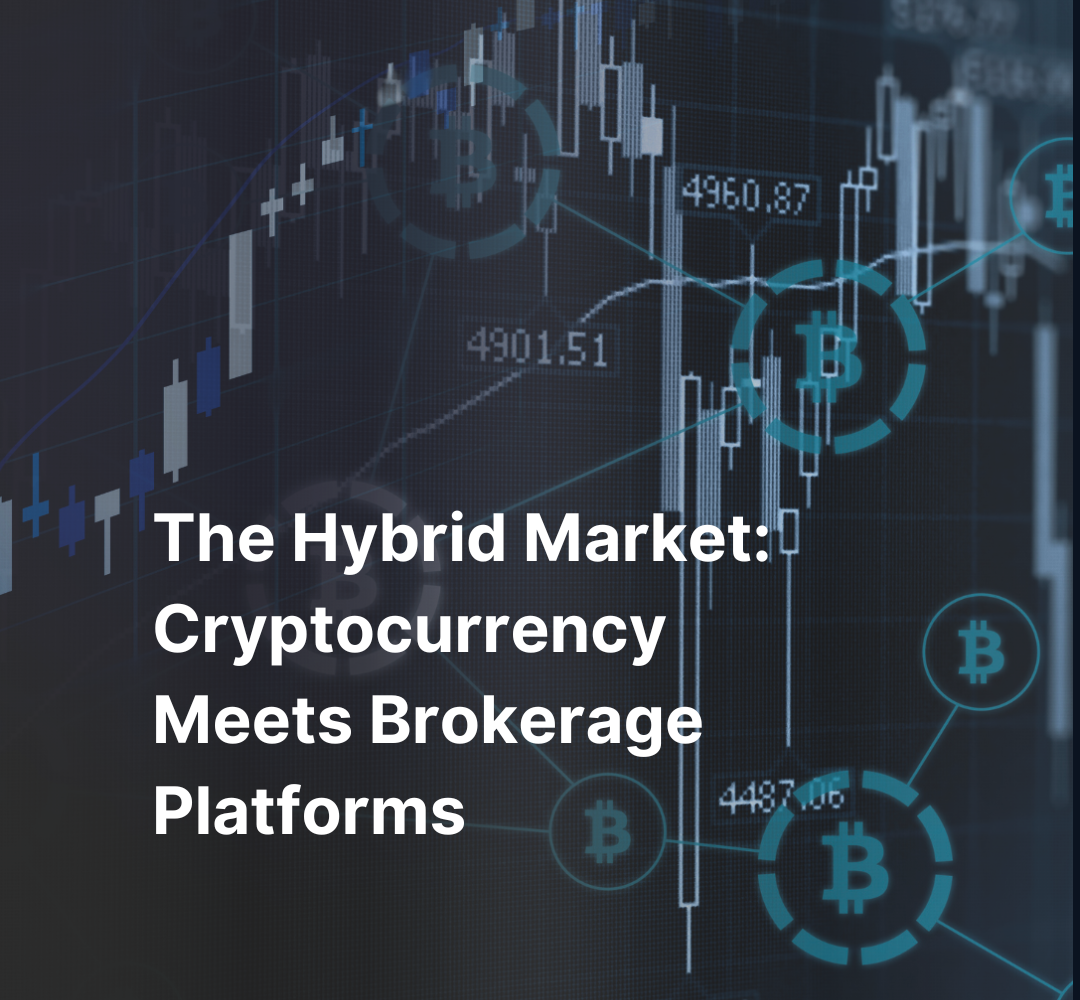As we inch closer to 2024, the DeFi space is becoming increasingly exciting, with its landscape evolving dynamically. Though the entire blockchain space promises rewarding opportunities, DeFi particularly shines, offering possibilities that looked distant just a few years ago.
The world of decentralized finance, or DeFi, is going through an interesting phase, and it is expected to be even more exciting in 2024. The emerging trends like the rise of Bitcoin DeFi, layer-2 scaling, DAO, NFT integration, and integration of traditional assets with DeFi will change its landscape even further.
Being an emerging Web3 solution provider in the industry, we have observed a few key trends that we believe will shape DeFi’s landscape. These trends will become more prominent as we herald into 2024 and beyond.
The Future of DeFi: Emerging Trends and Growth Opportunities
The popularity of the DeFi space is surging so rapidly that the global decentralized market is expected to surpass $231 billion by 2030, according to Grand View estimate. Other statistics also confirm this trend. According to DeFi Lama, the total value unlocked in DeFi is $51 billion by 2023. A report on DeFi by Wharton University says that DeFi’s growth will be fuelled by stablecoins, credits, derivatives, insurance, and asset management categories.

1. Bitcoin DeFi: Solving the Big Puzzle
Currently, smart contracts only run on the Ethereum Virtual Machine based on the shared state. Bitcoin’s native scripting doesn’t allow the writing of smart contracts over its protocol. However, RGB and Taro are working on introducing smart contracts to the Bitcoin protocol. Though they are not ready for practical adoption, we may see rising interest in this direction.
2. Layer 2 Scaling Solutions: The Next Big Thing
With rising demand for scalable, cost-effective, and user-friendly blockchain solutions, Layer 2 scaling solutions are set to dominate the decentralized finance blockchain space. The allure of faster financial transactions and throughput is irresistible. The concept of Layer 2 scaling solutions has gained currency with the surge in the popularity of the Ethereum blockchain protocol and the launch of Optimistic Rollups and zk-Rollups.
3. Cross-Chain Interoperability: Bridging the Divide
Despite the decline of many crypto platforms, the number of blockchain protocols supporting DeFi has significantly increased, mainly due to its flexibility and utility. Consequently, the demand for cross-chain interoperability will only strengthen in 2024 and beyond. Polkadot, Avalanche, and ATOM are leading, but more supporting protocols are expected to enhance the DeFi ecosystem.
4. NFT Integration: The Future of Digital Ownership
The attraction of NFTs continues to grow, and DeFi is adapting accordingly. More DeFi platforms will adopt NFT integration for lending, collateralization, NFT pools, NFT staking, cross-platform liquidity aggregator, and governance, giving birth to new use cases.
5. Crypto Bridges: Bridging Blockchain Network
The blockchain world remains fragmented, but serious efforts are underway to bridge this divide. Crypto bridges are becoming essential, changing how crypto assets are transferred across various blockchain networks. More interoperable solutions like DX25 will emerge, fostering unified cross-chain transactions.
6. Liquidity Aggregators: Addressing Interoperability Challenge
The number of cross-platform liquidity aggregators is rising, thanks to cross-chain interoperability and Layer 2 scalability. They solve a crucial interoperability challenge by pooling liquidity from various decentralized exchanges (DEXs) across chains, including their cross-chain pools.
7. The Promise of Modular Protocols: New Era of Blockchain
Scalability issues have long plagued blockchain protocols, mainly due to the need for approval from all nodes, leading to congestion and delays. Modular blockchain protocols tackle this issue by dividing the workflow into several parts where its layered approach speeds up transactions by allowing parallel processing. Thus, the DeFi ecosystem is likely to see increased modularity.
8. Decentralized Exchanges: Making a Comeback
The collapse of centralized cryptocurrency exchanges has led to a shift towards decentralized crypto exchanges (DEX). This is evident from the surging trade volumes and increasing market share data, even in a bear market. Uniswap is the leader in the DEX space, but more such decentralized platforms may evolve in the future.
9. Decentralized Identity Verification: The Future of KYC
The growing interest in DeFi has spurred the development of a secure, decentralized KYC and identity verification system. This has led to the emergence of blockchain-based KYC solutions, giving users control over their data while meeting regulatory and compliance requirements.
10. Real World Assets (RWA) And DeFi: Blurring Lines
The distinction between traditional real-world assets and DeFi is increasingly blurring. A new hybrid asset class is emerging, driven by the growing institutional adoption of DeFi protocols. This includes assets like DX25, combining traditional finance’s trust and reliability with the agility and innovation of DeFi.
Real-world assets, such as real estate commodities, are now used in DeFi lending protocols, minimizing the risk for lenders while providing more financing opportunities for borrowers. For instance, a property owner can easily take a loan using their property as collateral.
11. DAO: Reshaping The Governance
DAO stands for Decentralized Autonomous Organization, a blockchain-based decentralized governance system. They provide enhanced transparency and audibility in the management layer. The adoption of DAO-based solutions is set to increase, with significant implications for enforcement, voting, charity, and overall corporate governance.
The rise of DAO governance in 2023, especially after the FTX collapse, indicates a trend expected to accelerate in 2024, aiming to prevent similar failures.
12. Stablecoin Adoption: The Shift from Niche to Mainstream
As they are closely tied to real-world assets, the popularity of stablecoins is continuously growing. For instance, Circle’s USDC and Maker’s DAI maintain high market capitalizations even in bear markets.
With increasing acceptance and emerging use cases, stablecoins are gaining traction. For example, Japan, which has been strict towards crypto tokens, has lifted its ban on foreign-origin stablecoins. Their utility suggests other countries may follow suit.
13. DeFi Gaming: The Future of Gaming Monetization
DeFi space has witnessed a strong surge in gaming as the number of play-to-earn gamers has increased. Plus, NFT integration enhances the gaming experience. Gamers benefit from DeFi as it has helped in commercializing the gaming industry.
For example, gamers can use their NFTs as collateral to borrow or lend tokens to play games and grow their passive income on platforms like Decenterland or Axie Infinity. BitSport, a crypto platform for gamers, allows them to fund various gaming competitions. Some more gaming platforms will likely emerge, fostering industry monetization using DeFi protocols.
Closing Thoughts
The DeFi landscape is dynamically evolving. As the aforementioned trends unfold further, they will collectively drive the expansion and growth of the DeFi ecosystem.
Looking for the right partner to launch your DeFi project? We offer end-to-end DeFi solutions to bring your project to life. Get ready to Launch your DeFi project with confidence.
Reach out to our experts to get started!


